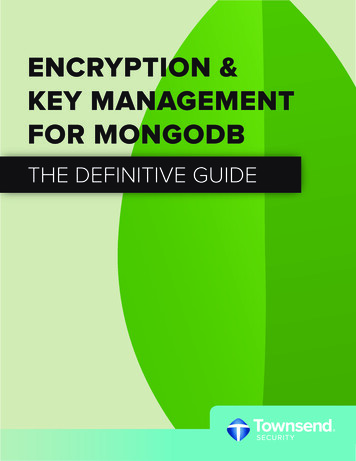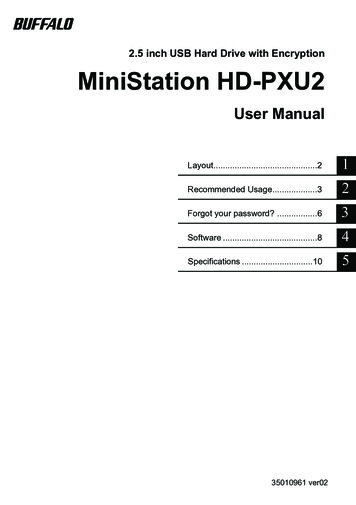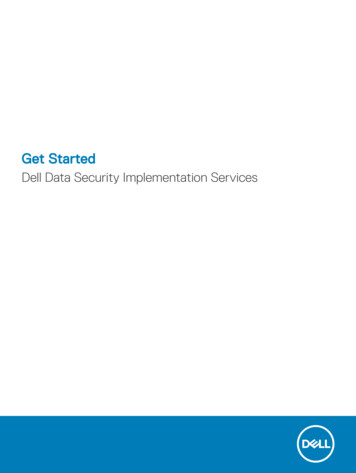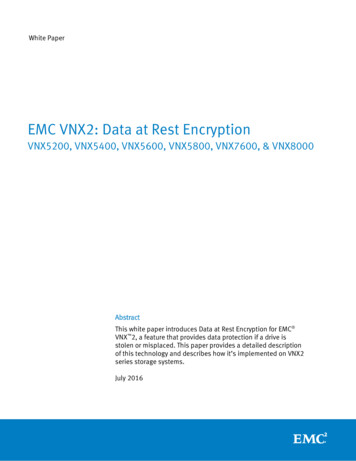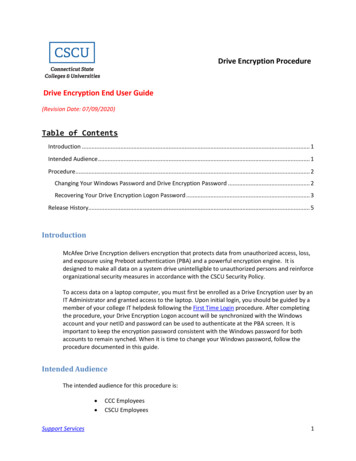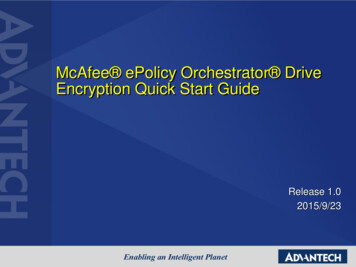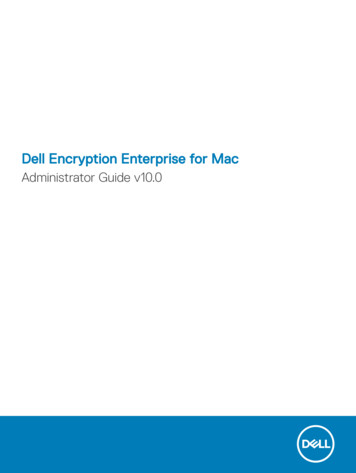
Transcription
Technical BriefMicrosemi Adaptec SmartStorage maxCrypto: SuperiorData-at-Rest EncryptionJuly 2018
Microsemi Adaptec SmartStorage maxCrypto: Superior Data-at-Rest EncryptionContentsRevision History . 1Revision 1.0 . 1Introduction . 2Threats to Data Security . 2Unauthorized Access or Theft . 2Storage Drive Disposal . 2Data Encryption . 2Software-Based Encryption . 2Advantages of Software-Based Encryption . 2Disadvantages of Software-Based Encryption . 3Hardware-Based Self-Encrypting Drive (SED) . 3Advantages of SEDs . 3Disadvantages of SEDs . 3Hardware-Based Encryption-Enabled Storage Adapters . 3Advantages of Encryption-Enabled Storage Adapters . 3Disadvantages of Encryption-Enabled Storage Adapters . 3Adaptec Smart Storage maxCrypto . 4Highlights . 4Enabling maxCrypto . 4Conclusion . 6Microsemi Proprietary and Confidential. Technical Brief Revision 1.0
Microsemi Adaptec SmartStorage maxCrypto: Superior Data-at-Rest EncryptionRevision HistoryThe revision history describes the changes that were implemented in the document. The changes arelisted by revision, starting with the most current publication.Revision 1.0Revision 1.0 of this document was published in July 2018. This was the first publication.Microsemi Proprietary and Confidential. Technical Brief Revision 1.01
Microsemi Adaptec SmartStorage maxCrypto: Superior Data-at-Rest EncryptionIntroductionData security has become one of the highest priorities for data centers and cloud computingenvironments as they seek to safeguard customer information, classified company documentation andcommunications, financial records, employee payroll records, and other confidential data. Solutions fordata-at-rest encryption are now a security requirement in many market segments such as health care,finance, e-commerce, federal government branches, and insurance—representing a significant overallpercentage of the deployed storage. In fact, government legislation is now in place mandating datasecurity and privacy, such as the Health Insurance Portability and Accountability Act, Gramm–Leach–Bliley Act, Sarbanes–Oxley Act, and the European Union General Data Protection Regulation.Data center managers face the challenge of safeguarding data while still meeting continually-increasingperformance demands for large-scale applications such as web serving, file serving, databases, onlinetransaction processing (OLTP), machine learning, and high-performance computing (HPC).Threats to Data SecurityMcAfee estimated that the cost of cybercrime and data breaches was 600 billion in 2017 alone.Security policies need to safeguard data from both Internet-based threats and physical threats to data atrest.Unauthorized Access or TheftFirewalls and other network security tools do an admirable job of keeping data safe from hackers, butthe threat of unauthorized access or physical theft remains.Storage Drive DisposalWhenever a storage device is removed from the data center—whether it is being returned to thevendor for replacement, resold, or recycled—the data it contains must be protected from unauthorizedaccess.Data wiping is one option for securing the drive outside of the data center, either with block writes orinstant secure erase. Encryption techniques are another protection method—these are discussed indetail in the following section.In cases where security is of the utmost importance, customers may choose to shred the device inaddition to data wiping and encryption.Data EncryptionEncryption is a method of encoding information so that it can only be read by using the proper key. Theencryption process can be software-based or hardware-based. While the CPU is responsible forpowering software-based encryption, hardware-based encryption is performed within a chip located onthe drive itself or on the storage adapter.Software-Based EncryptionSoftware-based encryption is managed by the operating system, using an application to encrypt anddecrypt data as it is read from or written to the drives using the host CPU.Advantages of Software-Based EncryptionSoftware applications are available for the major operating systems and work with all brands ofHDDs and SSDsCan offer many advanced features such as data-in-place encryption and re-key supportStorage systems may experience added latency and I/O performance degradationLacks a common implementation between versions of operating system (for example, Windows/Linux)Degrades the performance of other applications running on the main CPUMicrosemi Proprietary and Confidential. Technical Brief Revision 1.02
Microsemi Adaptec SmartStorage maxCrypto: Superior Data-at-Rest EncryptionDisadvantages of Software-Based EncryptionStorage systems may experience added latency and I/O performance degradationLacks a common implementation between versions of operating system (for example, Windows/Linux)Degrades the performance of other applications running on the main CPUHardware-Based Self-Encrypting Drive (SED)On a self-encrypted SSD or HDD, the encryption/decryption process takes place independent of the CPUand OS, using a chip on the drive utilizing a symmetric key securely generated and stored on the device.Advantages of SEDsDedicated cryptographic hardware, yielding little to no impact to latency or I/O performanceTransparent to the host operating system and host CPUIndependent of the storage adapter in useDisadvantages of SEDsDrives that support encryption must be purchased and deployed, requiring additional inventorycomplexity and possibly additional costSecuring existing storage infrastructure requires replacing all existing HDDs and SSDs with SEDsCurrent data must be transferred from existing non-encrypted drives to new SEDs (that is, there isno support for data-in place encryption)Datapath between the host operating system and the SED is in plaintext, allowing opportunities fordata snoopingHardware-Based Encryption-Enabled Storage AdaptersOn an encryption-enabled storage adapter, the encryption/decryption process takes place independentof the CPU and OS, using a chip on the adapter instead of the drive.Advantages of Encryption-Enabled Storage AdaptersDedicated cryptographic hardware, yielding little to no impact on latency or I/O performanceTransparent to the host operating system and host CPUOne adapter encrypts multiple drives, reducing capital expenses and deployment complexityCompatible with all brands of SAS and SATA HDDs and SSDs where a RAID volume is supported,spanning one or multiple drivesAllows data centers to deploy a uniform, scalable encryption strategy across the entire enterpriseData is encrypted on the storage subsystem, avoiding data snooping on the adapter cache, attachedcables, or expanders, all the way to the media of the driveAllows for selective encryption enablement and unique encryption keys per logical volumeSupport for data-in-place encryption while the volume remains accessible during the encryptionprocessDisadvantages of Encryption-Enabled Storage AdaptersRequires purchasing an encryption-enabled storage adapterRequires the use of a RAID volume to store data as currently implemented by Smart StorageMicrosemi Proprietary and Confidential. Technical Brief Revision 1.03
Microsemi Adaptec SmartStorage maxCrypto: Superior Data-at-Rest EncryptionAdaptec Smart Storage maxCryptoAvailable on the SmartRAID 3162-8i/e version of the Smart Storage series of storage adapters,maxCrypto hardware encryption delivers data protection with little to no impact on latency or I/Operformance. Leveraging the SmartROC 3100 RAID-on-Chip (RoC) controller, the Smart StoragemaxCrypto solution allows data centers to deploy a uniform, scalable encryption strategy across theenterprise.maxCrypto HighlightsHighlightsAdaptec maxCrypto data encryption for HDDs and SSDs when configured for a RAID volume for datastorageAvailable on the SmartRAID 3162-8i/eEfficient—one adapter encrypts multiple drives, reducing capital expenses and deploymentcomplexityFlexible—compatible with all brands of SAS and SATA HDDs and SSDs, and can be enabled onany type of RAID volumeUniform security policy—allows data centers to deploy a single, scalable encryption strategyacross the entire enterpriseHighly secure—encrypted data path from the adapter to the drive mediaMulti-tenant security—unique encryption keys per logical volumeLine-rate speeds with minimal impact on latency or performanceDoes not require separate key management softwareSuperior cryptography256-bit XTS-AES encryptionTweak value per LBA (encryption key is altered per LBA making the encryption very difficult tobreak)Disk capacity remains unalteredEnabling maxCryptoEnabling maxCrypto encryption for one or more logical volumes attached to the adapter is easy Usingthe security administrative role of maxCrypto, the encryption functionality is enabled by entering amaster passphrase. Logical volumes can then be created with encryption enabled or disabled utilizingthe Smart Storage management tools. Per the security policy of the data center, the same master keypassphrase can be used for all adapters in the data center or, alternatively, unique passphrases may beused. Migrating encrypted drives from one adapter to another is as easy as re-entering the matchingmaster passphrase in the replacement adapter.Microsemi Proprietary and Confidential. Technical Brief Revision 1.04
Microsemi Adaptec SmartStorage maxCrypto: Superior Data-at-Rest Encryptionmaster passphrase in the replacement adapter.Once enabled, the encrypted data is inaccessible without the matching master passphrase and amaxCrypto-enabled adapter. Because it operates automatically (in the background), maxCrypto doesnot interfere with day-to-day storage operations such as drive replacement and logical drive creation orcommon tasks associated with storage administration.Microsemi Proprietary and Confidential. Technical Brief Revision 1.05
Microsemi Adaptec SmartStorage maxCrypto: Superior Data-at-Rest EncryptionConclusionData centers face a growing responsibility to safeguard sensitive data such as customer identities,company communications, and financial records. Data-at-rest on drive media is open to compromisewhen appropriate safeguards are not observed. By encrypting data-at-rest, a data center can ensurethat unauthorized parties will not be able to read the data when drives are removed (eitherintentionally or unintentionally).Software encryption comes at the expense of valuable CPU resources. Self-encrypting drives offer a highperformance hardware-based solution but require significant operational overhead and do not providethe security and flexibility of controller-based encryption.maxCrypto hardware-based encryption is available on the SmartRAID 3162-8i/e and delivers the highestlevels of data protection with minimal impact on latency. It integrates seamlessly into existing storageinfrastructures and allows data centers to deploy a uniform, scalable encryption strategy across theentire data center.Ordering InformationSmartRAID3100SeriesPartNumberRaid heBackupmaxCryptoSmartRAID3162-8i/e2299600R0, 1 ,5, 6, 10,50, 60, 1 ADM,10 ADM8-LanePCIeGen 38internal2 encryptionMicrosemi Proprietary and Confidential. Technical Brief Revision 1.06
Microsemi Adaptec SmartStorage maxCrypto: Superior Data-at-Rest EncryptionMicrosemi makes no warranty, representation, or guarantee regarding the information contained herein or the suitability of its products and servicesfor any particular purpose, nor does Microsemi assume any liability whatsoever arising out of the application or use of any product or circuit. Theproducts sold hereunder and any other products sold by Microsemi have been subject to limited testing and should not be used in conjunction withmission-critical equipment or applications. Any performance specifications are believed to be reliable but are not verified, and Buyer must conduct andcomplete all performance and other testing of the products, alone and together with, or installed in, any end-products. Buyer shall not rely on any dataand performance specifications or parameters provided by Microsemi. It is the Buyer's responsibility to independently determine suitability of anyproducts and to test and verify the same. The information provided by Microsemi hereunder is provided "as is, where is" and with all faults, and theentire risk associated with such information is entirely with the Buyer. Microsemi does not grant, explicitly or implicitly, to any party any patent rights,licenses, or any other IP rights, whether with regard to such information itself or anything described by such information. Information provided in thisdocument is proprietary to Microsemi, and Microsemi reserves the right to make any changes to the information in this document or to any productsand services at any time without notice.Microsemi HeadquartersOne Enterprise, Aliso Viejo,CA 92656 USAWithin the USA: 1 (800) 713-4113Outside the USA: 1 (949) 380-6100Sales: 1 (949) 380-6136Fax: 1 (949) 215-4996Email: sales.support@microsemi.comwww.microsemi.com 2018 Microsemi. All rights reserved. Microsemi and the Microsemi logoare trademarks of Microsemi Corporation. All other trademarks and servicemarks are the property of their respective owners.Microsemi, a wholly owned subsidiary of Microchip Technology Inc. (Nasdaq: MCHP), offers a comprehensive portfolio of semiconductor and systemsolutions for aerospace & defense, communications, data center and industrial markets. Products include high-performance and radiation-hardenedanalog mixed-signal integrated circuits, FPGAs, SoCs and ASICs; power management products; timing and synchronization devices and precise timesolutions, setting the world's standard for time; voice processing devices; RF solutions; discrete components; enterprise storage and communicationsolutions; security technologies and scalable anti-tamper products; Ethernet solutions; Power-over-Ethernet ICs and midspans; as well as custom designcapabilities and services. Microsemi is headquartered in Aliso Viejo, California, and has approximately 4,800 employees globally. Learn more at www.microsemi.com.ESC-2181400Microsemi Proprietary and Confidential. Technical Brief Revision 1.07
Encryption is a method of encoding information so that it can only be read by using the proper key. The encryption process can be software-based or hardware-based. While the CPU is responsible for powering software-based encryption, hardware-based encryption is performed within a chip located on the drive itself or on the storage adapter.


